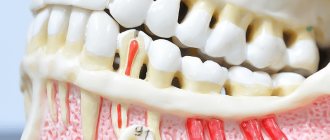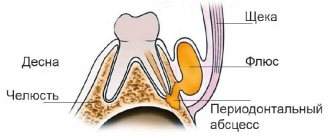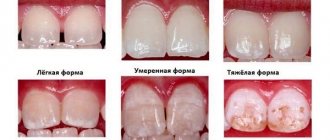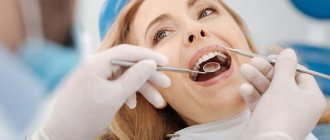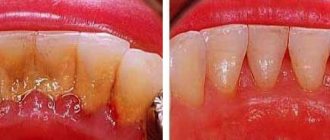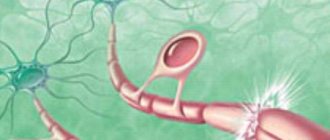Carrying out any surgical interventions in the area of the facial part of the skull, including dental procedures, is extremely dangerous due to the close location of important anatomical structures. When performing seemingly simple tasks during surgery, damage to atypically located nerves, vessels, and ducts of the salivary glands is possible, which leads to significant complications. Numbness after sinus lifting and bone grafting can appear at different stages of the operation and postoperative period; its causes can be very diverse and closely intertwined.
A little about the anatomy and course of the branches of the trigeminal nerve
The teeth of the upper and lower jaw are innervated by the branches of the trigeminal nerve, which provide all types of sensitivity directly to the teeth, skin and mucous membrane of the lips and cheeks. The lower jaw - by the mandibular nerve, the upper - by the alveolar branches of the maxillary nerve, forming the dental plexus.
The alveolar branches of the maxillary nerve pass along the wall of the maxillary sinus to the apexes of the roots of the upper teeth, where they form a nerve plexus responsible for the sensitivity of the upper teeth and gums. The mandibular nerve passes through the bone canal of the same name, innervating the lower teeth and gums, lower lip, and part of the cheek.
Prevention
There are many reasons for numbness in the teeth and part of the face, which were listed earlier. To discard any of them would be wrong. In this matter, the only thing that depends on a person is how closely he monitors the general state of his health, as well as the health of his teeth.
To avoid problems with the trigeminal nerve, you need to visit the dentist in a timely manner, treat caries and other dental diseases in a timely manner, and engage in preventive measures.
Periodically, professional teeth cleaning and mineralization may be required. Teeth numbness is a very unpleasant problem; if it is not prevented or corrected in time, it can even lead to paralysis of the jaw. But at an early stage, you can get rid of numbness by taking medications prescribed by your doctor. But the symptoms of the disease are usually treated, but the underlying cause is not eliminated.
Characteristics of sinus lifting and bone grafting
Bone grafting in dentistry is designed to increase the volume of bone tissue to create suitable conditions for placing a dental implant. An increase in the volume of hard tissues can be carried out both through the use of one’s own bone material and with the use of synthetic substitutes. Bone grafting is performed on both the lower jaw and the upper jaw.
Sinus lifting is an operation performed exclusively on the upper jaw and, in essence, is a type of bone grafting. Its task is to raise the bottom of the maxillary sinus in order to increase the volume of bone mass. Additional bone material can be either your own or artificial. There are two ways to perform a sinus lift: open and closed. They differ in the complexity of execution and the ability to add different amounts of bone tissue.
Dental implant placement should not be confused with bone grafting or sinus lifting. These are two different operations, although they can be performed simultaneously. If there is initially a small amount of bone tissue, it may not be possible to place a dental implant immediately. Then, first, bone tissue is built up, and only a few months later, an artificial tooth is implanted.
Ways to treat if the upper and lower jaw are numb
Treatment when the upper jaw or some teeth, such as the front teeth, go numb should be carried out taking into account the cause of the disease. Damage to the jaw nerve can also be eliminated non-surgically, it all depends on what factors caused it. The main condition for successful treatment is timely provision of assistance. Other treatment options are microsurgery, physiotherapy, and taking special medications.
If your teeth have been numb for more than three months, it will be difficult to restore their sensitivity. Therefore, the sooner you seek professional help, the better.
In addition to taking special medications, the doctor may prescribe physiotherapeutic techniques to the patient. Main options:
- electrophoresis of teeth with calcium (it is applied to the affected part of the face);
- UHF;
- dynamic currents;
- laser therapy. A similar technique can be used to eliminate caries. Find out more about laser treatment for caries here.
The treatment program in each case is drawn up individually, the doctor considers the advisability of using certain therapeutic techniques for a particular patient.
At the moment, different methods of treating the trigeminal nerve are used, and they all have their own characteristics. In the initial stages, anti-seizure medications are often prescribed to prevent the seizure from progressing. Doctors may prescribe antispasmodics, sedatives, and vascular medications.
Sometimes trigeminal neuralgia is treated with folk remedies - for example, amphibian knotweed decoction or yarrow infusion. You can target the affected area with a laser - this method is applied across the fields in the area where the nerve branches exit the skull, cutaneously.
Surgical treatment of trigeminal neuralgia is quite complex, and doctors do not agree on its effectiveness. The first method of surgical therapy consists of trephination of the cranial fossa from the back and restoration of the correct location of the roots relative to the arteries and veins.
During compression, they are separated - a gasket is placed between the spine and the vessels, which prevents the vessels from affecting the spine. But there is a nuance here - the effect of blood vessels on the nerve is not always the main cause of the disease, so such actions may simply not bring the desired results.
The second method of surgical therapy is percutaneous radiofrequency destruction of the roots. It involves the impact of thermal energy when high-frequency currents pass through biomaterials. This method has a number of advantages compared to the first - the main ones are low trauma and the use of local anesthesia, which means quick recovery.
It is precisely because of the high degree of trauma that surgical methods of treatment are used relatively rarely.
Causes of numbness after surgery
It should be immediately mentioned that numbness associated with anesthesia will not be considered, since it is a normal reaction to the administration of the drug. Anesthesia can be maintained to one degree or another from several hours to a day, after which sensitivity returns in full and sometimes painful sensations of varying severity are observed. Also, a slight decrease in sensitivity may persist due to existing edema, which is a variant of the normal condition.
Severe loss of sensation occurs when the branches of the trigeminal nerve are damaged or compressed.
Problems in the lower jaw
Loss of sensitivity after bone grafting, like any other surgical interventions, is much more common in the lower jaw. This is due to the fact that during surgery, with an atypically high location of the mandibular canal or a small amount of bone tissue, nerve damage or compression may occur.
Nerve damage during surgery
Thanks to the widespread use of radiography and computed tomography, such a complication is now extremely rare. It may be associated with an atypical location of the mandibular canal, fragility of bone tissue, or medical error.
During the process of access, removal of tooth root debris, and formation of new bone tissue, the nerve may be damaged by the instrument or compressed by excessive amounts of new bone mass. In this case, after the end of anesthesia, numbness of the teeth anterior to the site of bone grafting, the lower lip, chin, and part of the cheek may persist.
Nerve compression due to implant displacement
If a dental implant changes its location due to injury, inflammation, or violation of medical instructions, compression of the mandibular nerve may occur. A similar situation can develop both in the first days and weeks after surgery, and after a long time.
With such a nerve trunk injury, extremely severe pain may initially be felt, and only then numbness may appear.
Nerve compression due to abnormal healing
After bone grafting, the slow process of new bone formation begins. Sometimes regenerative processes follow a pathological path, when newly formed tissues compress surrounding structures, blood vessels, and nerves.
This condition develops gradually, over 1-3 months after surgery. Numbness also does not appear immediately. Initially, it may be almost invisible or appear occasionally, passing after some time. Over time, numbness may increase or may remain at the same level.
Numbness during dental implantation
Incorrectly performed dental implantation is one of the most common factors leading to numbness of the front teeth. Sometimes the main reason is unsuccessful anesthesia, since during the injection process the needle may well damage the jaw nerve and lead to loss of its sensitivity.
The syndrome occurs as a result of erroneous determination of the length of the implant. In this case, after the procedure of its implantation, the nerve is either injured or pinched.
There are several stages of numbness, which can be caused by a dentist’s mistake during installation of implants.
At the stage of neuropraxia, only partial numbness is observed, which usually lasts several hours and disappears either on the day of surgery or the next morning.
At the stage of axonotmesis, symptoms persist for about a month and are accompanied by pain.
The most severe form is neurotmesis, in which numbness is accompanied by the appearance of a scar and disappears no earlier than two months after implantation.
All of these listed forms are not the norm, so the appearance of any stage of jaw numbness should be discussed with your doctor and undergo an additional course of treatment if necessary.
Problems in the upper jaw
Numbness after sinus lifting and bone grafting in the area of the upper teeth and gums is less common than in the lower jaw. This is due to the fact that the innervation of these structures is carried out by three groups of branches of the maxillary nerve, intertwined with each other and forming the dental nerve plexus. Such a structure is quite difficult to damage or completely disable.
The loss of sensitivity in the area of the upper lip and upper half of the cheek cannot in any way be associated with dental interventions due to the fact that completely different branches of the maxillary nerve go to them.
Damage to the alveolar branches or dental plexus
This complication can only develop in conjunction with penetration into the maxillary sinus during surgery, which should not occur if the operation is performed correctly.
Local, mild numbness develops. One or two teeth may be involved with incomplete loss of sensitivity.
Improper placement of the implant or complications in the postoperative period
Dislocation of the skeleton of a prosthetic tooth can occur due to injury, inflammatory processes, or neglect of the dentist’s recommendations. Diagnosis of this condition is not particularly difficult due to the obvious pathological state of the implant.
There may be loss of sensitivity due to chronic odontogenic sinusitis. The condition develops over a long period of time, occurs with severe symptoms of sinusitis, and numbness develops in extremely severe and advanced cases.
Symptoms
The clinical picture of the pathology is associated with its type - primary or secondary.
Primary numbness occurs due to inflammation of the oral cavity or damage to nerve fibers.
If the gums are numb due to primary paresthesia, symptoms appear:
- burning;
- tingling;
- feeling of swollen gums;
- increased discomfort while eating;
- "crawling" feeling.
Other symptoms of numbness also include:
- exacerbation of symptoms by the end of the day;
- dry mouth;
- in some cases - weakening of taste buds.
Secondary numbness is characterized by:
- the presence of unpleasant sensations lasting from 2 days to several years;
- disappearance of tingling sensations when eating food;
- lack of effect from analgesics.
Secondary paresthesia occurs due to pathologies of organs and systems.
Diagnostics
If partial or complete numbness occurs after sinus lifting and bone grafting, you should undergo a number of diagnostic procedures:
- Examination of the oral cavity by a dentist. Allows you to assess the general situation and in some cases even make a diagnosis immediately. Must go through first. If there is displacement of the implant or nerve injury during surgery, then further examination methods can be of a purely clarifying nature.
- Assessment of neurological status based on damaged branches of the trigeminal nerve. This task is more likely for a neurologist, rather than for a dentist. By testing reflexes and using special methods to determine sensitivity, it is possible to assess the presence/absence of nerve damage.
- X-ray or computed tomography. These examination methods make it possible to establish in detail and accurately the cause of loss of sensitivity. With the use of modern technologies, it becomes possible to calculate down to the millimeter the direction and degree of displacement of the installed structure, existing pathological foci of regeneration, and determine the presence of an inflammatory process both at the site of bone grafting and directly in the maxillary sinus.
Treatment of gum numbness
Treatment of gum numbness is aimed at eliminating the pathology that provoked a decrease in the sensitivity of soft tissues. The choice of treatment method depends on the severity of the disease and includes the following steps:
- Reduced pain and discomfort.
- Elimination of dental problems:
- sanitation of the oral cavity;
- treatment of inflammatory processes of the gums;
- grinding sharp edges of teeth.
- Treatment of neurological diseases.
Treatment options
If the nerve trunk, plexus or branches of the nerve are damaged or compressed, there are two ways to solve the problem.
The first is to leave everything as is, without performing surgery. Such a solution to the problem is acceptable in case of incomplete loss of sensitivity or a small area of focus, with the exception of cases with displacement of the denture. Compression of the nerve due to regenerative processes will stop progressing after a certain point, “frozen” in one place. Odontogenic sinusitis can be treated with medication using antibiotics.
The second method is to perform surgery. The operation is indicated for injuries during sinus lifting and bone grafting, displacement of dentures or bone mass, extensive or complete loss of sensation. During the operation, the cause of the numbness is eliminated and, if necessary, the damaged nerve is sutured. Restoration of sensitivity takes a long time, sometimes never returning to its original state.
Basic treatment methods
Tooth numbness is usually treated by a dentist. First of all, you should find out the cause of the syndrome. If you notice signs of paresthesia, you should make an appointment with a dentist.
In some cases, the syndrome is corrected without surgery. Sometimes it will be necessary to perform an operation using one of the methods of jaw microsurgery.
The main goal of therapy in both cases is to restore sensitivity to the jaw nerve. It is extremely important to take into account that if the disease continues for three months, the likelihood of successful treatment is noticeably reduced, and if paresthesia persists for more than one year, it becomes almost impossible to completely restore tooth sensitivity.
Ways to relieve tooth sensitivity
If the face is hypothermic, doctors recommend taking antihistamines and trying to increase body temperature to increase blood flow.
During treatment in a dental office or during the rehabilitation period after surgical correction of the mandibular nerve, physiotherapeutic treatment procedures are of great benefit:
- electrophoresis, which is usually used together with painkillers;
- UHF procedures;
- laser therapy;
- exposure to affected areas with diadynamic currents.
All these procedures are not mandatory and are prescribed based on the doctor’s opinion of their appropriateness.


